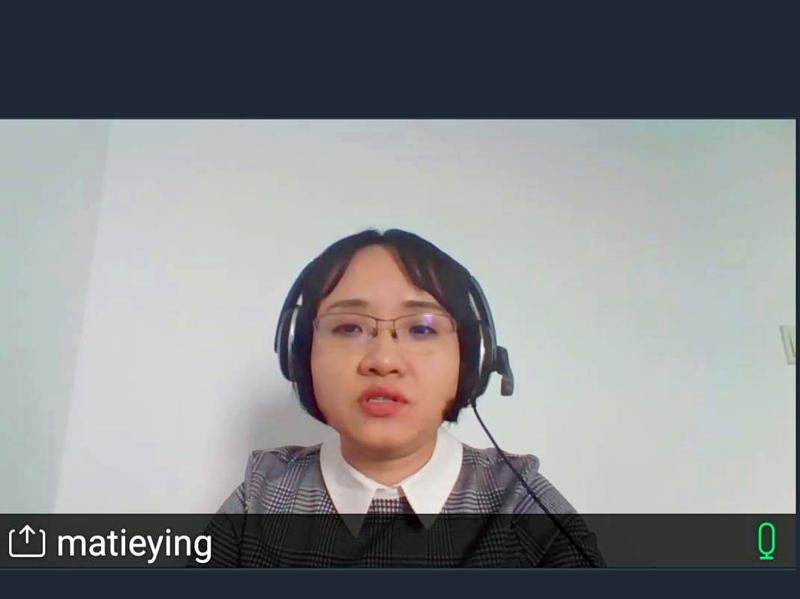DBS Bank Ltd yesterday revised upward its GDP growth forecast for Taiwan to 5.5 percent this year, from the 5 percent it predicted in April, citing better-than-expected investments.
Imported capital goods advanced 63.5 percent in August, indicating that local manufacturers, especially those in the semiconductor industry, increased their investments, Singapore-based DBS economist Ma Tieying (馬鐵英) told a videoconference.
Data for last month had not been released, but the momentum in July and August should have remained intact last month, Ma said.

Photo: Lee Chin-hui, Taipei Times
“With annual growth of 7.4 percent, Taiwan’s economy in the second quarter was brisker than expected,” she said.
“We also boosted our forecast for the third quarter to 4 percent, from 3.8 percent predicted in April, due to strong investment and recovering consumption in July and August,” she added.
However, the bank slashed its growth estimate for the fourth quarter from 3 percent to 1.8 percent, as export growth might slow to a single-digit rate compared with an annul rise of 31 percent in the first eight months of this year, Ma said.
“Exports will likely face headwinds, as demand from China could decline due to the country’s power rationing, which would limit production of Chinese electronics companies,” she said. “China is the largest market in terms of exports of intermediate electronics from Taiwan.”
Taiwan’s exports to China, including Hong Kong, have increased at declining rates for five months in a row, from 35 percent annual growth in March to 16 percent in August, she said.
Taiwan’s exports to Southeast Asia also slowed last month, with nations in the region reporting COVID-19 outbreaks that interrupted production and reduced import demand, Ma said.
“These negative factors have not fully been reflected on Taiwan’s economy and might become more obvious in the fourth quarter,” Ma said. “In an even worse scenario, these factors could continue existing and slowing the local economy in the first quarter next year.”
DBS Bank’s 5.5 percent growth forecast is lower than the 5.88 percent predicted by the Directorate-General of Budget, Accounting and Statistics (DGBAS).
The bank predicted 2.8 percent growth next year, also lower than the DGBAS’ 3.69 percent projection.
The central bank would stay put this quarter, as the labor market has not improved much, Ma said.
However, it might raise its policy rates in the second quarter of next year at the earliest, if employment improves, she said.

Shiina Ito has had fewer Chinese customers at her Tokyo jewelry shop since Beijing issued a travel warning in the wake of a diplomatic spat, but she said she was not concerned. A souring of Tokyo-Beijing relations this month, following remarks by Japanese Prime Minister Sanae Takaichi about Taiwan, has fueled concerns about the impact on the ritzy boutiques, noodle joints and hotels where holidaymakers spend their cash. However, businesses in Tokyo largely shrugged off any anxiety. “Since there are fewer Chinese customers, it’s become a bit easier for Japanese shoppers to visit, so our sales haven’t really dropped,” Ito

The number of Taiwanese working in the US rose to a record high of 137,000 last year, driven largely by Taiwan Semiconductor Manufacturing Co’s (TSMC, 台積電) rapid overseas expansion, according to government data released yesterday. A total of 666,000 Taiwanese nationals were employed abroad last year, an increase of 45,000 from 2023 and the highest level since the COVID-19 pandemic, data from the Directorate-General of Budget, Accounting and Statistics (DGBAS) showed. Overseas employment had steadily increased between 2009 and 2019, peaking at 739,000, before plunging to 319,000 in 2021 amid US-China trade tensions, global supply chain shifts, reshoring by Taiwanese companies and

Taiwan Semiconductor Manufacturing Co (TSMC, 台積電) received about NT$147 billion (US$4.71 billion) in subsidies from the US, Japanese, German and Chinese governments over the past two years for its global expansion. Financial data compiled by the world’s largest contract chipmaker showed the company secured NT$4.77 billion in subsidies from the governments in the third quarter, bringing the total for the first three quarters of the year to about NT$71.9 billion. Along with the NT$75.16 billion in financial aid TSMC received last year, the chipmaker obtained NT$147 billion in subsidies in almost two years, the data showed. The subsidies received by its subsidiaries —

Taiwan Semiconductor Manufacturing Co (TSMC) Chairman C.C. Wei (魏哲家) and the company’s former chairman, Mark Liu (劉德音), both received the Robert N. Noyce Award -- the semiconductor industry’s highest honor -- in San Jose, California, on Thursday (local time). Speaking at the award event, Liu, who retired last year, expressed gratitude to his wife, his dissertation advisor at the University of California, Berkeley, his supervisors at AT&T Bell Laboratories -- where he worked on optical fiber communication systems before joining TSMC, TSMC partners, and industry colleagues. Liu said that working alongside TSMC